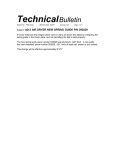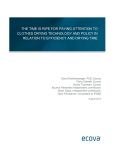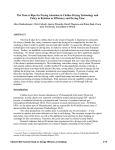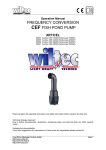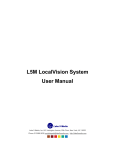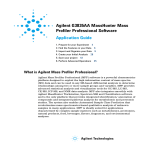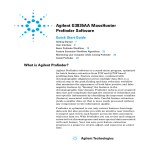Transcript
ENERGY STAR® 2014 Emerging Technology Requirements: Advanced Dryers Performance Characteristic Requirements Required Documentation Product Performance CEF ≥ 5.5, achievable in at least one setting, terminating at a remaining moisture content of ≤5%3 1 2 Energy Efficiency - Standard Clothes Dryers CEF > 5.0, achievable in at least one 4 setting Third party laboratory performed test results consistent with DOE test method, unless otherwise noted, found in 10 CFR part 430, subpart B, appendix D2 CEF > 4.1, achievable in the "normal" cycle < 80 minutes to finish each tested 5 cycle CEF ≥ 6.6, achievable in at least one setting, terminating at a remaining moisture content of ≤5%3 1 6 Energy Efficiency - Compact Clothes Dryers Default Setting CEF > 6.0, achievable in at least one 4 setting Third party laboratory performed test results consistent with DOE test method, unless otherwise noted, found in 10 CFR part 430, subpart B, appendix D2 CEF > 4.5, achievable in the "normal" cycle < 80 minutes to finish each tested 5 cycle The most efficient setting to dry a normal load of clothes shall be set as the default Copy of user manual or design documentation Additional Company Requirements Product Commercialization Plan Training and Installation Plan Required New companies** must submit and EPA must approve a Product Commercialization Plan for the U.S. market that includes: market size, commercialization partners, targeted applications, targeted regions, and staffing plan to support plan implementation Required New companies** must submit and EPA must approve a Training and Installation Plan for the U.S. market that includes company details on delivering technical training to installers 1 Combined Energy Factor (CEF) = The clothes dryer test load weight in pounds divided by the sum of the per cycle standby and off mode energy consumption and either the total per-cycle electric dryer energy consumption or the total per-cycle gas dryer energy consumption expressed in kilowatt hours (kWh). Measured according to the U.S. Department of Energy (DOE) test method for Clothes Dryers (10 CFR 430, Subpart B, Appendix D2). Unless otherwise specified, compliance with specification limit shall be evaluated using exact values without any benefit from rounding. 2 Standard Clothes Dryer = A clothes dryer with drum capacity of 4.4 cubic feet or greater. Drum capacity is assessed per the DOE test method for Clothes Dryers at 10 CFR 430, Subpart B, Appendix D2, Section 3.1. All test conditions, unless otherwise noted in this document, shall be consistent with the DOE test method found in 10 CFR 430, Subpart B, Appendix D2. 3 For purposes of this requirement, the manufacturer may use the most energy efficient temperature, dryness, and auto terminating cycle selection with the DOE test method to achieve the required CEF (5.5 for standard dryers or 6.6 for compact dryers). In addition, the product is permitted to terminate the cycle at a remaining moisture content (RMC) of ≤5%, in lieu of the ≤2% required by the DOE test method. All other test conditions shall be consistent with the DOE test method found in 10 CFR 430, Subpart B, Appendix D2. 4 For purposes of this requirement, the manufacturer may use the most energy efficient temperature, dryness, and auto terminating cycle selection with the DOE test method to achieve the required CEF (5.0 for standard dryers or 6.0 for compact dryers). All other test conditions and termination requirements shall be consistent with the DOE test method found in 10 CFR 430, Subpart B, Appendix D2. 5 The amount of time needed to finish one complete cycle according to the DOE test method found in 10 CFR Part 430, Subpart B, Appendix D2. "Cycle" means a sequence of operation of a clothes dryer which performs a clothes dryer operation, and may include variations or combinations of the functions of heating, tumbling and drying. For purposes of this requirement, the test lab must record the amount of time required to finish one complete test cycle for each of the three tested modes. 6 Compact Clothes Dryer = A clothes dryer with drum capacity of less than 4.4 cubic feet. Drum capacity is assessed per the DOE test method for Clothes Dryers at 10 CFR 430, Subpart B, Appendix D2, Section 3.1. All test conditions, unless otherwise noted in this document, shall be consistent with the DOE test method found in 10 CFR 430, Subpart B, Appendix D2. ** New Companies are defined as companies that do not have more than 100 retail outlets for their products, sold under their own brand name. March 11, 2014

